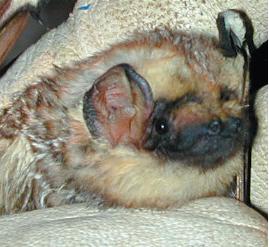Field Guide/Mammals/Hoary Bat
< Field Guide | Mammals
| Lasiurusc cinereus (Hoary Bat) | |
|---|---|
|
Family: Vespertilionidae
Size: Total Length: 5.3 inches (134.5millimeter)
Tail Length: 2.3 inches (57.5millimeter) Weight: .7-1.2 ounces (20-35 grams)Description: Black to dark brown starting at the base, followed by a cream colored band, and then a strip of mahogany brown. Has a yellowish-brown collar under its chin along with black-rimmed yellow ears. Has long, soft fur that starts at the tip or the tail and ends by the wrists on the underside of the wings.
Similar Species: This species is one of the few tree-dwelling bats that is spread widely throughout North and South America.
Range: The hoary bat has a range from Argentina and Chile, extending northward into Canada. They are mostly concentrated in the Plains States and the Pacific Northwest.
Habitat: This species can mainly be found in forests with small open areas and live in hollowed out areas, like woodpecker holes and squirrel nests. Females normally nest in deciduous trees, while the males prefer coniferous trees. Most bats favor areas that have dense vegetation above and no obstructions below their nest, allowing them to drop and gain flight.
Diet: The hoary bat focuses its diet on moths and beetles along with mosquitos.
Activity: In the winter months, this species migrates to coastal areas around south San Francisco, from South Carolina to central Florida, and throughout the Gulf States. They are nocturnal and feed once in the early evening and once before sunrise.
Reproduction: Females usually give birth between the middle of May and the end of June. Litter size ranges from one to four pups. Young are born blind and deaf, with their ears and eyes opening 3 days after birth. They learn to fly 33 days after birth.
Lifespan: The hoary bat lives for 6 to 7 years.[1]
|
 |
- ↑
Texas Parks and Wildlife, Hoary Bat (Lasiurus cinereus), retrieved 9-23-12
{{citation}}: Check date values in:|accessdate=(help)